

During the late 1960s, the Boston Bruins had put together a fine team with the coming-of-age of Bobby Orr, who joined them in 1966, and a subsequent trade with Chicago in 1967 that brought Phil Esposito, Ken Hodge, and Fred Stanfield to Boston. The Bruins won the Stanley Cup in 1969 and 1971, and could have won five in a row because they were that good. In 1972, the World Hockey Association raided the “skinflint” Bruins, taking Derek Sanderson, Gerry Cheevers, and others, stopping the Bruins’ championship reign.
Bobby Orr, who is my choice as the best player I have ever seen play, had three speeds of fast. His little give-and-go pass, and then gone, was a treat to watch. He would leave me in his wake, and I had to learn to watch for it so I could catch up with the play. Since there was neither a two-man refereeing system in those days nor an instant replay, you had to be on the goal line to observe the puck go in. Orr won the Norris trophy as the best defenceman eight times, and twice won the scoring championship, which was unheard of for a defenceman. If knee injuries had not prematurely ended his career, he probably could still be playing today, and he is over sixty!
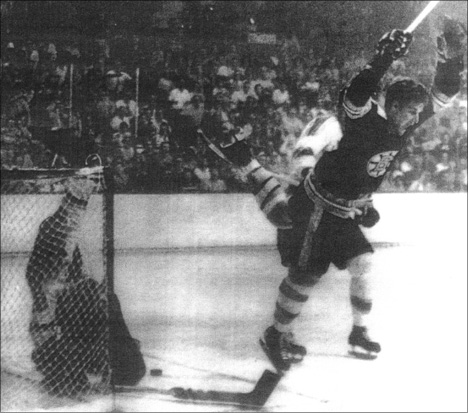
Bobby Orr, “The Boy Wonder.”
Bruce Bennett Studios
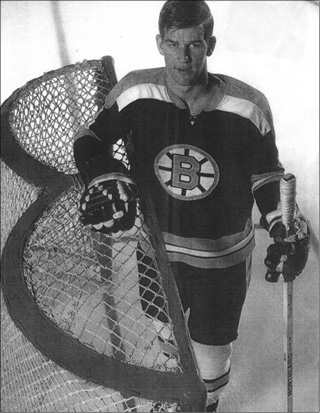
Bobby Orr.
Dave Sandford
Phil Esposito completed the second half of the Bruins’ great one-two punch. He would park in front of the opponent’s net in his “office” and was so big and strong that no one could move him.
Claude Ruel, the Canadiens coach, said he feared “Horr and Exposito” when they played the Bruins. They were a swashbuckling bunch of boys who were full of piss and vinegar. They had a lot of fun both on and off the ice. Some of their escapades are legendary. (They once wheeled Phil Esposito out of a Boston Hospital — in his hospital bed — to attend a Bruins year-end party.)
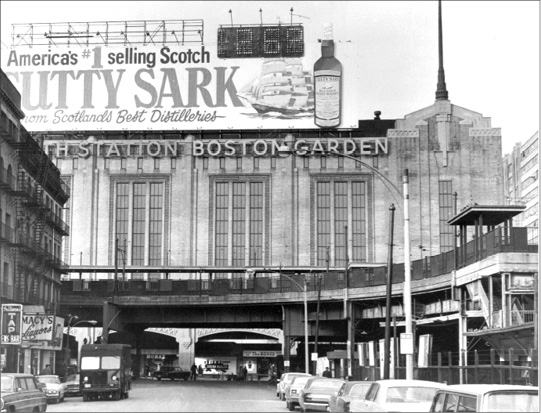
Boston Garden.
Hockey Hall of Fame
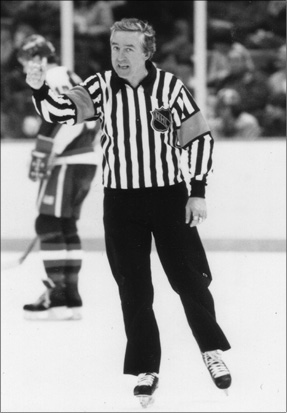
Ron on patrol.
Author’s Collection
One night in the old Boston Garden, I had ejected the Flyers’ Dave “The Hammer” Schultz from the game. On the way to his dressing room, he stopped in front of the Bruins’ bench, put his stick and gloves on the ice, and casually asked the Bruins players on the bench if they had any guts. Of course, about six guys stood up and came over the boards after him. They were led by Wayne Cashman and Stan Jonathan. It took all our resources, with a little help from the local constabulary, to eventually get Schultz to the Flyers’ dressing room, conveniently located right behind the Boston bench, and an ideal spot for a potential riot.
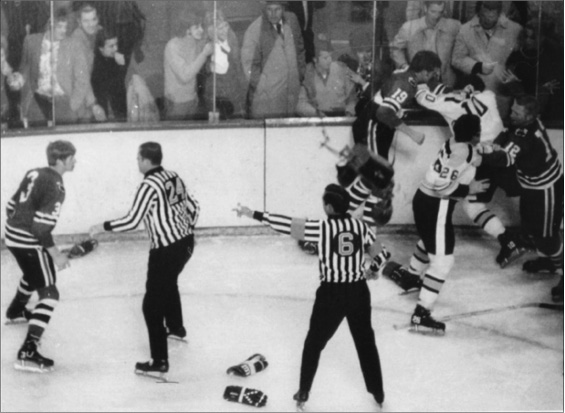
Fight night in Beantown.
Author’s Collection
The only good thing about all the on-ice game incidents is that I had to file an official report to the League president, and I have hundreds of these reports to refresh my memory.
I had been retired for a year when my buddy Bob Nutbrown and I decided to drive from Toronto to Montreal to watch the Bruins play the Canadiens in a playoff game. We went down to visit the referees before the game. The Bruins’ dressing room was right next door to the referees, and we ran into the Bruins GM, Harry Sinden, who shook my hand and said he missed me. Harry informed us that he was sick of all the new referees. Sure, sure — here was the same guy who only a few years earlier had kicked my referee’s door down!
The “Gardens” was built at the height of the great Depression in 1931. It held about 13,000 people, an unheard-of number in those days. Its owner, Conn Smythe, put together some great teams.23 They won the Stanley Cup numerous times. He and Foster Hewitt, the Leafs broadcaster, became as well known to Canadian fans as the Leafs stars. It was a great era in Canadian sports history.
Connie Smythe originally bought the Toronto St. Pats in 1927, when they played out of the Mutual Street Arena. He renamed the team the “Maple Leafs,” giving the club its distinct blue and white colours. My dad, Charlie, used to follow their exploits on a crystal set, thirty miles north in King City, Ontario. I still have a pair of skates that Dad bought in 1927, and I put them on once a year in his memory when I go for a pleasure skate outdoors at Gage Park, in Brampton. As you can imagine, Dad was just a little bit of a Leafs fan. I used to kid him that he had been vaccinated with a Maple Leafs pin, and he did not deny it.
Legendary Canadian broadcaster Foster Hewitt began radio broadcasts of the Toronto St. Pats in 1927 and continued to broadcast the Leafs games for many years. For most Canadians this was their introduction to hockey.24
The Toronto Maple Leafs held their training camp in Sudbury for several years in the 1950s. It was fun to go down and watch the pros work out and play exhibition games. Maple Leafs star George Armstrong, who was from neighbouring Falconbridge, was a delight to watch. I still run into “the Chief” at Brampton junior games, and he entertains me with stories of the old days.
The Leafs last won the Cup in 1967, when the gang of old-timers led by forty-two-year-old goaltender Johnny Bower, defenceman Allan Stanley (aged forty-one), Red Kelly (aged thirty-nine), Terry Sawchuk and Tim Horton (both aged thirty-seven), Captain George Armstrong, and Marcel Pronovost (both aged thirty-six) defeated a powerful Montreal squad to win the Stanley Cup. This ruined the Canadiens’ party, as Expo ’67 was being held in Montreal that year and the Habs wanted to showcase “their” Cup.
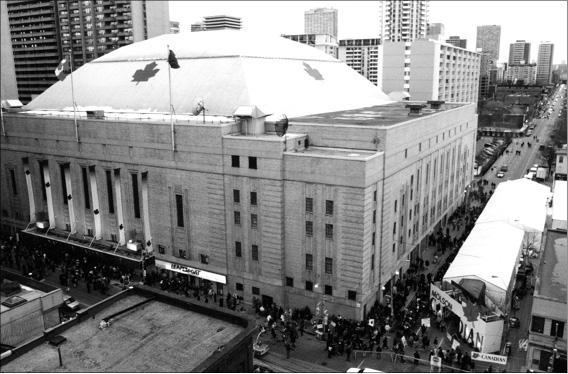
Maple Leaf Gardens.
Hockey Hall of Fame
Out of the Original Six, only the Chicago Black Hawks have led the League longer in futility, not having won the Cup since 1961. My son, Brian, who was born in 1971, fears he will never be able to see the Stanley Cup parade go up Bay Street in Toronto. He is not alone, and I just smile as I endure listening to the “Leafs Nation” supporters saying, “This is the year.”
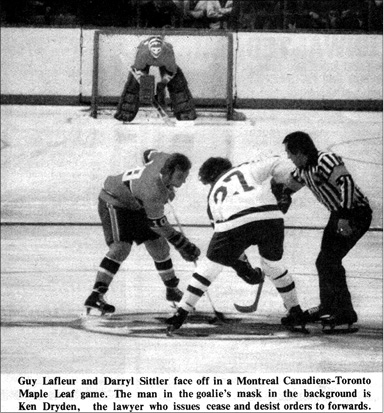
Opening face-off, Montreal and Toronto.
Toronto Star
A few years ago, I was at a skate-a-thon in Toronto and was chatting with the former Leafs great, Borje Salming. I mentioned that I once had saved his life when he played the Flyers, and he laughed. The incident took place in Toronto when he and Dave Hoyda were scrambling for the puck along the boards. Hoyda took off one glove put it under his arm and knocked Borje out cold with one barehanded punch. I threw Hoyda out of the game, and the Flyers management went ballistic. The League had put in rule that a player would be assessed a major penalty and a game misconduct for being the instigator or the aggressor in an altercation, but I guess the Flyers felt that one punch should have been a “freebie.”
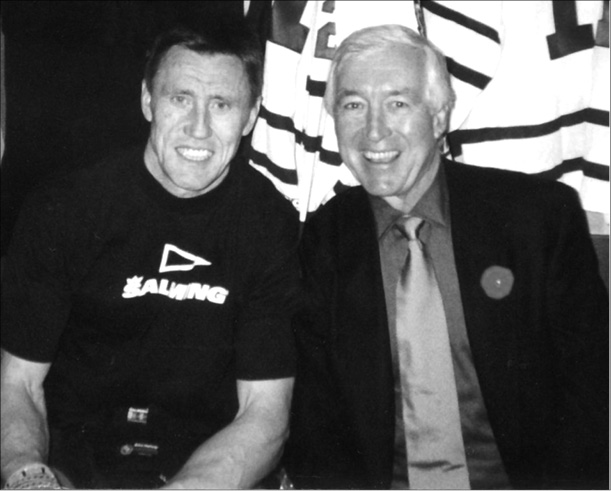
Borje Salming and Ron, NHL Hall of Fame game. Borje was Brian’s favourite player.
Author’s Collection
The Toronto Maple Leafs did not have a very strong team in the mid-eighties and had been known to blow leads. One night in Toronto, the Leafs were up, I believe 6–0, over the mighty Winnipeg Jets. Suddenly — bang — the game was tied up, and into overtime we went. Several minutes into overtime Winnipeg scored the winning goal. The Leafs’ captain, Rick Vaive, vigorously protested and said it was kicked into the net. I asked my linesman, Leon Stickle, who informed me that he saw the play the same way I did. We allowed the goal to stand and the Leafs lost the game.
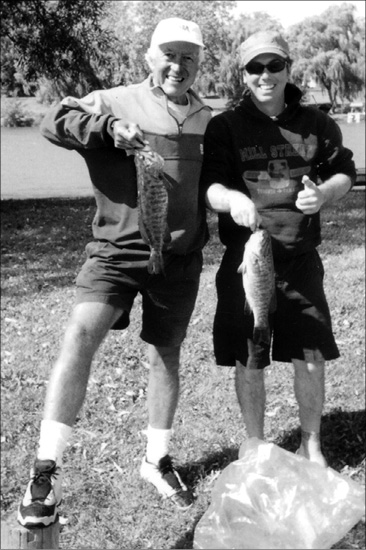
Ron and his son, Brian, fishing.
Author’s Collection
Vaive then got very abusive towards Leon and put his hockey stick between Leon’s legs. Then Leon suggested that Rick remove the stick or he (Leon) would remove it — or words to that effect. Leafs enforcer Dave Hutchison then entered the proceedings, and a further heated discussion took place between Hutch and Stick (something about how they used to tangle together when they played Junior Hockey and who used to wipe the other guy’s nose). I was right at the penalty box and decided not to interfere with this little chat, so I headed to my dressing room, leaving them to finish their discussion.
Leon drove me home after the game and we found my wife, Barb, all upset and writing a letter to the television network, describing a TV announcer who, while rolling his eyes skyward, had made inflammatory statements about my refereeing. This statement had resulted in an irate fan’s calling my home and saying that I was an f . . . g asshole. Then he hung up before she even had a chance to agree or not!
It was not easy being an impartial arbitrator in Leafs Nation; and all this crap took place because the Leafs had snatched defeat from the jaws of victory — once again.
My kid brother, Jim, is upset that now I am retired I’m still not a Leafs fan. He got a bit perturbed when I recently needled him with this question: “What do they call a Maple Leafs player holding the Stanley Cup?” Answer: “A visitor to the Hockey Hall of Fame!”
The New York Islanders entered the League along with Atlanta during the additional expansion of 1972, and, in their first year, had the worst record in league history. After the first few years, things changed for the better for the Islanders, and, through shrewd draft picks and the hiring of another Sudburian, Al Arbour, as their coach, they rose to prominence and won four Stanley Cups in the 1980s. They were led by their “shy” goaltender, “Battling” Billy Smith, who had a habit of waving his stick at players as they circled his net. His goalie stick would “inadvertly” (as he called it) make contact with the player as he came out on the other side of his net. This would be known as a slashing penalty in my books. On one occasion, he picked on the wrong guy, Wayne Gretzky. Big Dave Semenko, who was Wayne’s unofficial bodyguard, stood up on the Oilers bench and yelled at Billy. Billy invited him to come on down, and out he came for the ensuing faceoff, to the right of the Islanders’ net and right in front of Billy. Of course, the officials had prepared for battle stations (we folded our arms and let them go at it), and the festivities began.
On the faceoff, the puck bounced high up into the air. Semenko was looking up for the puck and Billy just casually skated out and stuck his big goalie’s stick right into Dave’s mouth and gave him a little nudge with the stick, causing a little blood to start to ooze from his mouth. Semenko was justifiably perturbed and sought revenge by placing his stick under Billy’s helmet and prying the helmet off his head. (I thought his head might come off, also.) They both fell to the ice and had a hell of a fight. When Dave brought his knee up into Billy’s groin area, Billy was deflated completely.
I threw Semenko out of the game for his indiscretions: five minutes for high-sticking, five for fighting, and five for kneeing, all of which earned him an automatic game misconduct for amassing three major penalties in a game.25 I imposed two major penalties on Billy, five for high-sticking, five for fighting, and a ten-minute misconduct. I deliberately left Billy in the game, even though he probably should have been thrown out. His backup goalie, Glen “Chico” Resch, was coming on the ice to replace Billy, but I said to Glen that Billy told me he wanted to stay and finish the game! Chico laughed and said later that it was one of the funniest incidents he had ever seen. I was at a golf tournament recently when Billy was the guest speaker, and I got up and rehashed the incident, with Billy and the crowd roaring during the storytelling.
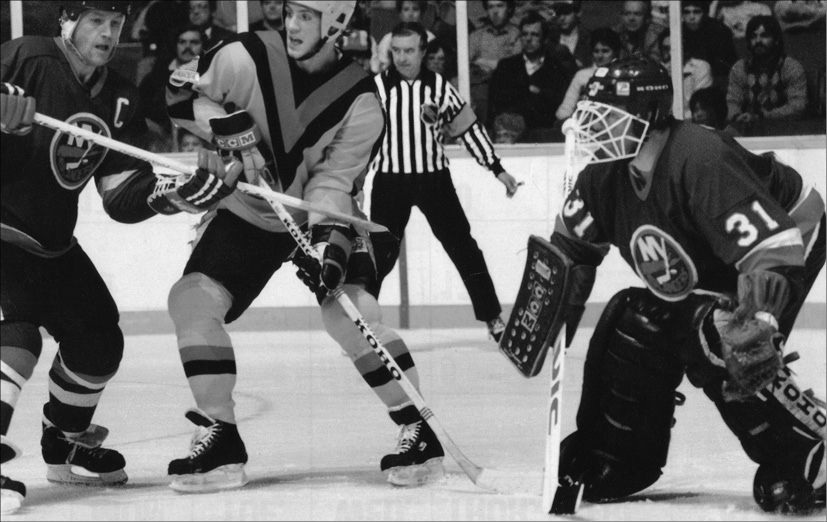
Vancouver Canucks and New York Islanders. Keeping one eye on the play
and the other on Billy Smith.
Vancouver Sun
The first game of the 1982 Stanley Cup finals, between the New York Islanders and the Vancouver Canucks, took place in Nassau Veterans Memorial Coliseum on Long Island. On the first power play of the game, Vancouver’s Dave “Tiger” Williams backed into Billy Smith’s goal-crease area. Billy jumped on him, and they wrestled and fell tangled up in the netting. The net ended up on top of them for several seconds while they flailed away at each other. This started the series off with a bang! The Islanders ended up winning the Cup in four straight games, although the Canucks put on a great show to keep the series interesting.
The Islanders had some very skilled players, including Mike Bossy, one of the premier “snipers” in hockey. He was the 1978 Rookie of the Year with fifty-three goals. He had nine consecutive fifty-goal seasons. Brian Trottier and Dennis Potvin were star players, but I always felt their inspirational leader was “Butch” Goring, who was not a big guy but led the way with his gutsy performance.
This 1982 Stanley Cup final series might have been the pinnacle of my refereeing career. The Vancouver Canucks coached by Harry Neale played Al Arbour’s New York Islanders. Both teams were fairly well matched, although it was the first time the Vancouver Canucks had played for the Cup. The Islanders had won the last two years and were playing for their third straight Stanley Cup. The Islanders won both games at home, but the games were very close. I remember Harry telling a reporter, who asked him if he was disappointed in the results, “When you look at the scoreboard for the out-of-town scores, and there aren’t any, you can’t be disappointed.”
Islander coach Arbour, goalie Billy Smith, and all-star defenceman Denis Potvin (with whom I did not always see eye to eye) collectively said I had refereed an excellent game. (I have the press clips, so you can’t deny it, guys!)
I recall flying out to Vancouver for the final games of the series. I played a round of golf at the Capilano Golf Club, attended the final game as the standby referee, and watched the Vancouver fans loyally wave a building full of white towels as their team went valiantly down to defeat in four straight games.26 Quite candidly, I could have wrapped up my career right then!
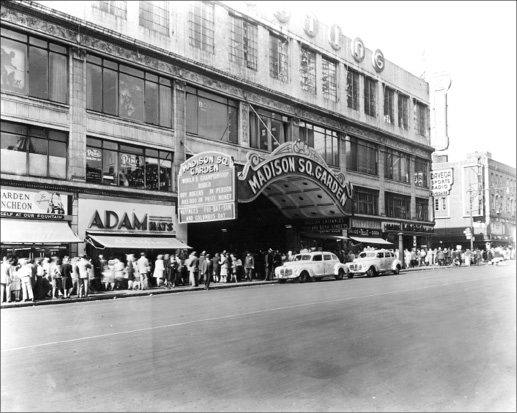
Madison Square Garden.
Hockey Hall of Fame
New York was known as the Boxing Capital of America, and the Big Apple teams — the Islanders and the Rangers — around 1975 had no love for each other. One Friday night in Manhattan, we had a twenty-five minute bench-clearing brawl. Rangers’ Nick Fotiu, a “golden glover” (who was a New York City product), and Gord Lane of the Islanders started things off, then Bob Nystrom and Ed Hospodar began to waltz. Of course, Islander goalie Billy Smith had to come out and join the festivities. Both benches then emptied, and a great time was had by all — except for us game officials, who had to write up our game reports. And if we screwed up and missed who did what to whom, with thirty guys running around the ice, somebody would try to say it was all our fault!
Guess what. The return match between the same clubs was the next evening in Long Island, and we had the same crap all over again. This time it took us only seventeen minutes to clean up the mess. In the main heavyweight event, Fotiu and Lane went at it again. Then the super heavyweights, Clark Gillies and Ed Hospodar, tangled, and the whole mess spilled into the Rangers’ bench area. Ranger goalie John Davidson left his crease and jumped into the fray.27 Goalies liked equal time.
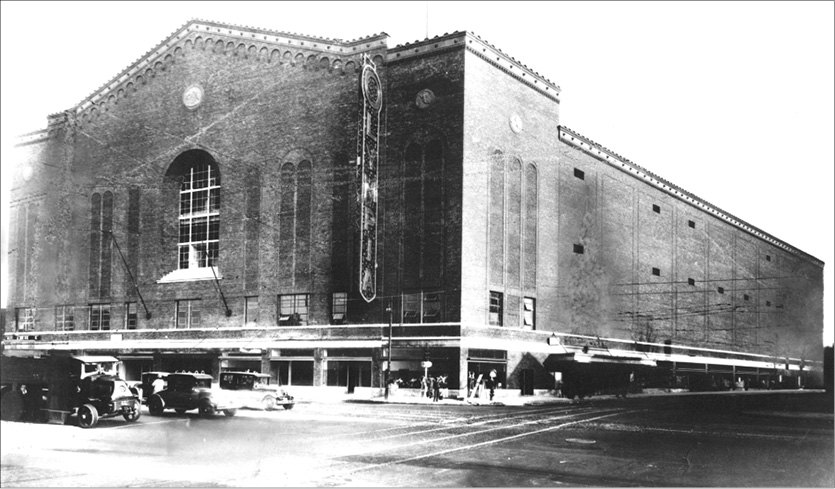
The Olympia.
Hockey Hall of Fame
Terry Sawchuck, Detroit’s brilliant goalie, who held the career record of 103 shutouts, had his finest moment in 1952 when he led the Red Wings to the Stanley Cup in the bare minimum four games required. Two games were shutouts and he allowed only one goal in each of the other two games. The Red Wings went on to win the Cup in 1954 and 1955. In 1955, two months after winning the Cup, Detroit GM Jack Adams traded Sawchuk, the Vezina Trophy winner, to Boston. (I have a footnote in my first hockey scrapbook and wrote that I cried when Terry was traded. Who says referees do not show emotion — even at fifteen years old?)
“Jolly Jack” Adams subsequently traded Ted Lindsay and other players who had had the temerity to try to start up a players’ association in the mid-1950s, proving he was not that smart a horse trader. He also traded All-Star Goalie Glenn Hall to Chicago in 1957. He depleted his team of star players just to show them who was in charge, and Detroit never won another Cup under Adams’ reign. The GMs and owners did not take kindly to any player who elected to rock the boat and display any independent thoughts!
Adams was not fond of referees. One night, referee Vern Buffey told Detroit player Bill Gadsby to “get lost.” (I was on the ice and recall he did not exactly use that term.) Adams stormed into our dressing room to object to the unparliamentary language Vern might have used. League president Clarence Campbell, who was in the room, backed up the referee’s choice of adjectives. He also informed Adams he would he reprimanded for violating the privacy of the referees’ room. “Jolly Jack” was not too pleased.
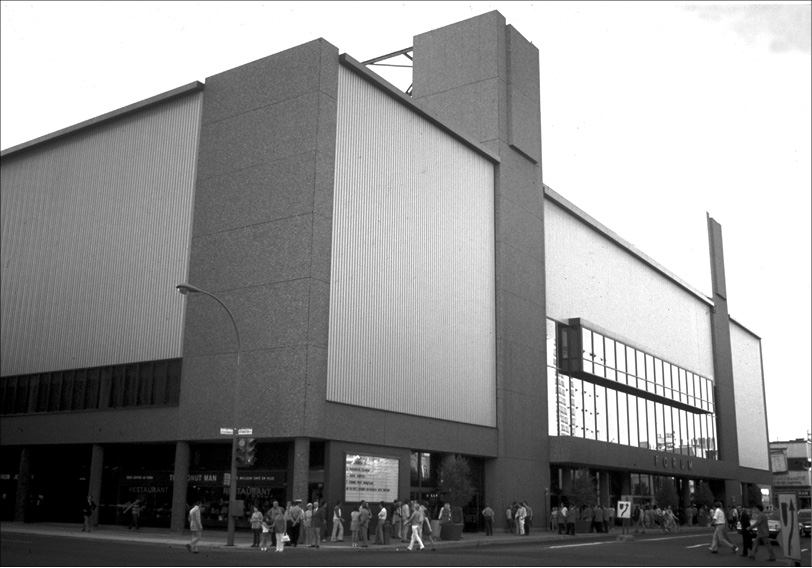
Montreal Forum.
Hockey Hall of Fame
Even though I was born and raised in English Canada, my favourite rink was the Montreal Forum — the Vatican of Hockey. What a great place to be on a Saturday night. The whole city and most of the province of Quebec was up for the game. Excitement was in the air! I recall that in 1961, Chicago won the Stanley Cup and dethroned the Canadiens, who had won it an unprecedented five years in a row, from 1955 to 1960. And now the media and press were on the Canadiens’ case. “What have you done for us lately?”

Stanley Cup game, Montreal, 1976; end run out of rink.
Montreal Gazette
The Black Hawk coach, Rudy Pilous, carried a miniature Stanley Cup in his pocket and when in Montreal would get to the Forum early, stand up on his empty players’ bench, hold up the Cup, and taunt the gallery gods, who stood around the upper tier of the Forum, by shouting in impeccable French, “C’est à moi” (“It’s mine”). A few thousand voices would try to drown him out. What a great way to start an evening.
Later in my career, Montreal had a wonderful tenor Roger Doucet, who would sing “O Canada” in both official languages. If a U.S. team were in town, he would belt out “God Bless America.” Wow! The best part of it was that Roger would do his pregame warm-up in our referees’ dressing room. I always got to the rink early to hear his warm-up, and we became good buddies. He put together a record called Songs of Glory, where he sang national songs of about twenty countries, including the Soviet national anthem in Russian. He autographed two copies for my parents — one in French for my French-Canadian mother, and one in English for my English father. They were keepsakes . . . I can still see Roger standing at centre ice belting out those anthems.
I have had the pleasure of being on the ice when some of Canada’s top tenors have sung the national anthems: Roger, John McDermott, and Michael Burgess — who played with the NHL Alumni team and sang with his equipment on. They were all charming guys.
The fact that I had attended a French school for five years came in handy during games in La Belle Province. Montreal star Yvon Cournoyer had complained about one of my calls, and I asked my French-Canadian linesman Gerard Gauthier: how do you pronounce “crybaby” in French? When I informed Yvon that he was a pleurer, he was flabbergasted that a guy with a name like Wicks could speak French. All three of us had a good chuckle.
In the 1970s, Montreal won six Stanley Cups, the first two in 1971 and 1972, then four in a row from 1976 to 1979. Guy Lafleur was their spiritual leader, and they had a solid defence core led by Serge Savard, Larry Robinson, and Guy Lapointe. Ken Dryden provided comfort in the net for them most of the way.
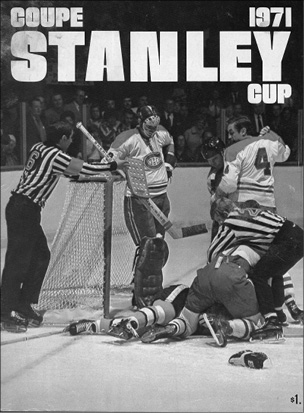
Stanley Cup, Montreal, 1971.
Denis Brodeur, NHL Images
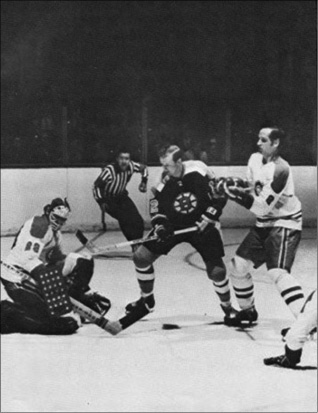
Montreal playoffs, action on net.
Denis Brodeur, NHL Images
Montreal’s Jean Beliveau was probably the classiest individual to play the game. He played on ten Stanley Cup championship teams, the last five as team captain. I recall his questioning me about an offside once, and years later I saw the replay and he was right. I did miss the call but he never made an issue of it. Jean was offered the role of Governor General of Canada, but elected to turn it down, as he was helping to raise his two granddaughters after their father (his son-in-law) had died.
During our surplus pension dispute with the League in the 1990s, Jean, who was vice-president of the Montreal Canadiens at the time, took a position supporting the case of the players. This really showed that he was a class act. Merci, Jean!
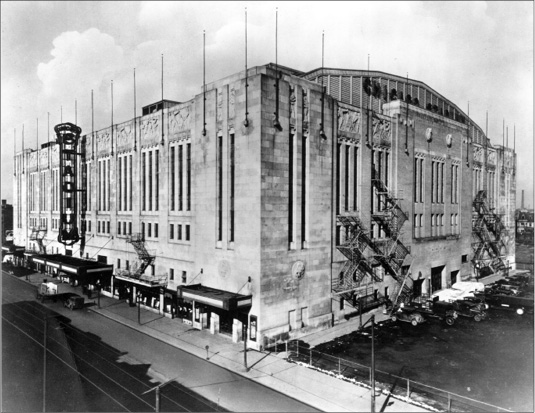
Chicago Stadium.
Hockey Hall of Fame
Chicago Stadium was the loudest building in the League. When the Black Hawks (now called the Blackhawks) scored a goal, a ship’s foghorn sounded that just about brought you out of your seat. I once sat up next to the rink organist, Al Melgard, and when the home club came onto the ice, the organ music was deafening. If you were going to see one hockey game, this was the spot to see it!
Fans at the old Chicago Stadium were real beauties and a treat to behold. One night as I climbed up the stairs to the ice surface to begin the game, one nice lady saw it was me, and blurted out “Oh my God!” My reply, “Not quite, my dear, not quite . . .” resulted in all of us having a great laugh.
Speaking of riots, I was the standby referee in a playoff game in Philadelphia in the early years of expansion, and the Flyers were playing the St. Louis Blues, who had a big, tough guy named Noel Picard. During an altercation, Picard flattened Claude LaForge and then dropped the Flyers’ resident tough guy, Ed Van Impe. Noel then gestured with his arms to the unruly crowd to come on down — and uniformed police officers, with shields on and police dogs, were soon marshalling in the bowels of the building. I was sitting with League president Clarence Campbell, who mentioned that if the players did not respect the officials’ rulings, he feared civil insurrection.28 I recall helping the on-ice referee, Bill Friday, piece together the game report after the festivities had cooled down.
Philadelphia was actually a great spot to referee a hockey game. The club brought in Kate Smith to sing “God Bless America,” and boy did that get the Spectrum hopping — as if it needed more excitement. The Flyers were led by the irascible Bobby Clarke, who would try anything to get the edge. He would rag on the referees before the game even started at the opening faceoff. When I was greeting the players, he would say, “Just drop the bloody puck!” On occasion, I threw him out of the pre-game faceoff, and that got the crowd going, which was exactly what he wanted.
The Flyers were nicknamed “the Broad Street Bullies,” and deservedly so. One time, around 1985, when Mario Lemieux, the Pittsburg star rookie, was playing in Philadelphia, one of the Flyers’ defencemen cross-checked him in front of the Flyers’ net and Mario ended up skidding right to centre ice. I had put my hand in the air to assess a penalty and by the time I got to the penalty box, I realized that a five-minute major penalty was in order. I told the penalty timekeeper (who was, ironically, wearing a helmet — in fact I asked him if I could borrow it, and we both laughed) not to announce the time portion of the penalty until I was safely shielded by the glass in the corner of the rink, as debris was going to be showered in my direction. I notice things have not changed in the “City of Brotherly Love” over the past twenty-five years.29
The Flyers, who were coached by Fred “The Fog” Shero, led the NHL in total penalty time for eight seasons in the decade of the 1970s.30 They had great penalty-killing skills — they could intimidate, take penalties, and physically beat their opponents into submission. They reached the Stanley Cup finals four times in this era and won the Cup twice.

Left: Philadelphia, game score card, Broad Street Bullies.Right: A quiet night on Broad Street.
National Hockey League
Occasionally, visiting teams would come down with the “Philadelphia Flu,” as their team bus approached town. One incident in my last year of refereeing, in 1985, when Mike Keenan was their coach, comes to mind.31 Two Flyers players were chasing two opponents and had pinned them into the Flyers’ bench area. Both my linesmen tried to restrain the Flyers players and grabbed them by the sweaters. Coach Keenan did not take kindly to his players’ being held by the game officials, so he reached out and grabbed my linesmen. I reached in and grabbed the coach by the shirt and told him to take his hands off the linesmen, or he would be coaching from the press box. We all dusted each other off and play resumed without further incident. On the next play in the corner, one of the Flyers came over, whacked me on the ass and said he was glad that someone had finally told his coach off.
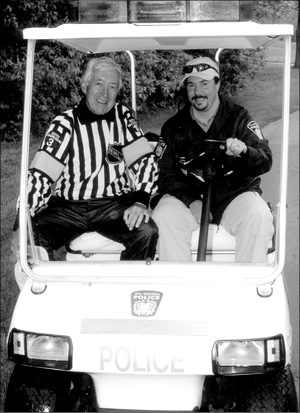
Police “escort.”
Author’s Collection
The Flyers chaplain was a nice Irish priest who would drop by our referees’ room before the games. I used to kid him that he was coming around to give us the last rites! Some nights I’m sure it was close. One year my record with Philadelphia was seven losses and no wins. (In plain English: When Wicks refereed, the Flyers never won a game!) The Philadelphia police were also on our side. One Sunday afternoon after a game, they hustled linesman Ray Scapinello and me into the back of a police jeep and took us from the rink right onto the airport tarmac to our waiting commercial flight back to Toronto. The look on the flight attendant’s face was priceless when the cop requested that she make sure “these fellows get out of town safely.” I’m sure she thought we were in the rackets!
During the ’80s, the Oilers won five Stanley Cups and for four of them were led by their boy wonder, number 99, Wayne Gretzky. I used to needle him on the ice and tell him that he was not that good — just lucky. That just fired him up more, while the puck followed him around the ice. One night, I think he got about eight points and I had to tell him he had potential.
I recall a funny incident out West. We were in Vancouver on a Friday night and Wayne, who was captain of the Oilers, came over to question me about a penalty call on his team. I politely informed him that a complaint about a penalty was not an interpretation of the rules, and he could only question penalties when invited to by the referee. I flew to Edmonton with the Oilers on the same commercial flight after the game, and I noticed Wayne perusing the rule book. I thought he was probably checking out the wording of the rule, and I figured that would be the last I would hear from him.
The next night, I called an interference penalty on Oilers star defenceman, Paul Coffey, who never complained about the call. And lo and behold, guess who was following me to the penalty box area questioning the call, but Wayne. I informed him that if he wanted to find out why the penalty was called, he could go and ask Paul. And so I gave my daughter’s favourite player, number 99, a minor penalty for unsportsmanlike conduct. Well, of course the Edmonton crowd went nuts, and it was soon compounded when the visiting team scored two power-play goals. The post-game open-line radio shows had a ball cutting me up right after the game. Later, when we stopped by the Firemen’s Club for a nightcap, they were not going to let me in.
I have had an opportunity to spend quality time with Wayne’s dad, Walter, at various Oldtimer hockey games and golf tournaments, and can see why Wayne turned out to be such a good person. His mom and dad had instilled solid qualities in him. Walter recently told me about a funny incident in a game when Wayne was about nine years old. Paul Reinhart, who ended up in the NHL, hit Wayne hard into the boards, and Walter’s mom, Grandma Gretzky, came down and hit Paul with her purse.
Walter has recently been appointed a Member of the Order of Canada for his various charity works. It is a well-deserved honour for a fine individual.
The St. Louis Blues drafted a mature team. In goal they had Glen Hall and Jacques Plante. Scotty Bowman was their crafty coach. They had the three Plager brothers on defence, who created mayhem in their wake. One night all three brothers were chasing the Leafs’ Eddie Shack around the ice. Some comment about “the three little pigs” got their attention. Barclay Plager was the best player of all the brothers; his motto was, “The willingness to fight is more important than the ability to fight” (the fighter’s creed). And to think that their father, Gus, was a referee!
The Blues’ owner, Sid Salomon Jr., said the referees had a vendetta against his club and as a result threatened to sell the club. He should have been out on the ice with us some nights in St. Louis. It was a wild and wacky spot; we referees had some interesting nights there. I once asked the Blues owner’s son, Sid Salomon III, if he would like to work the lines when our regular linesmen got snowed in and could not make the game. He respectfully declined.
An incident took place in St. Louis one night. Boston thought they had scored (as did the goal judge, since he had put the red light on). The referee waved the goal off, and the play kept right on going. St. Louis picked up the puck, went down the ice, and they scored a goal. Now you had both goal lights flashing, and a siren going off cheering the hometown goal. You also had both coaches, Harry Sinden of Boston and Al Arbour of the Blues, skidding around the ice trying to get the referee’s attention. After consulting with the linesmen, the referee ultimately allowed the first goal (the visiting team’s) to stand. Apparently it took a while to get the game restarted!
Fortunately everyone got out alive but we changed our officiating procedures. When there was a goal light flashing and the “scored upon” team got possession of the puck, the referee would stop play immediately.
The Minnesota North Stars were a fine expansion team led by Wren Blair as their coach and GM. Nicknamed “The Bird,” he was a showman extraordinaire. He would hoot and holler, and I usually did not pay any attention to him (shades of Don Cherry). He used to bang the boards with his fist. I recall going off the ice and noticing him holding his bruised hand in the trainer’s ice bucket. When I asked him, “How’s the hand doing?” his reply was not for public consumption.
Clarence Campbell, the League President, tried to harness Wren in, usually to no avail. Interestingly, years later, Wren bought into the financially strapped Pittsburg Club and became one of Mr. Campbell’s bosses.
23 Major Conn Smythe fought in both the first and second Word Wars. His motto, and the Maple Leafs’ motto was, “If you can’t beat them in the alley, you won’t beat them on the ice.”
24 Newfoundland entered Canadian Confederation on July I, 1949, ending one of the most famous broadcast introductions to the game (“Hello Canada and hockey fans in the United States and Newfoundland”) — and geography lessons, as we would all check out the world maps to see where Newfoundland was located.
25 After he retired, Semenko ended up fighting Muhammad Ali in an exhibition boxing match in Edmonton, so Billy may have picked on the wrong guy — but he had guts.
26 The white towel incident took place earlier in the playoffs when the Vancouver coach, Roger Neilson, waved a white towel in the form of surrender — in protest to a referee’s ruling. Roger was replaced by Harry Neale as the coach. Roger was a great guy, very innovative. His nickname was “Captain Video” and he was way before his time!
27 As Connie Smythe, the former Leafs owner, used to say, “If this keeps up, we will have to print more tickets.”
28 “Civil insurrection” was Mr. Campbell’s favourite term for a riot.
29 Philadelphia is Greek for “brotherly love” and the Flyers rink, The Spectrum, was on Broad Street.
30 I first met Fred Shero when he was the coach of the St. Paul team. We would run into each other later when he coached Buffalo in the American League and Philadelphia in the NHL in the 1970s. He was a terrific coach, and was nicknamed “The Fog.” He was way ahead of his time in coaching skills, and his club, the Flyers, won two Stanley Cups.
31 “Iron Mike” Keenan has coached for numerous teams in the League. His shelf life is generally three to four years. His first year coaching in Calgary was 2007; however, on May 22, 2009, after two consecutive first-round playoff losses, Keenan was fired as head coach of the Calgary Flames. He had one year left on his contract.